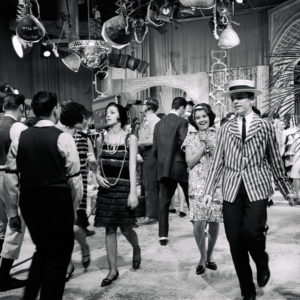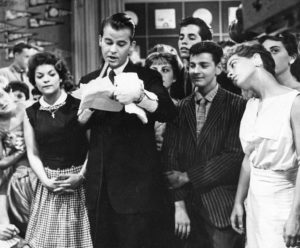
Rock and roll music. Television. These two very potent forces of the 50’s combined to create a juggernaut of a television series that possibly every single Boomer watched at least once. It was a regular Saturday afternoon ritual for me in the early 70’s, until I became observant enough to note that many of the artists were lip-syncing. By then, the Midnight Special was on, and that’s where I got my fix of genuine live music at the much cooler time of late Friday nights.
But that doesn’t mean that AB was a bad show. On the contrary, the fact that it began as a Philadelphia local in 1952 that soon became a national staple that ran until 1989 shows that there was something very, very special about American Bandstand.
It all began with Philadelphia station WFIL on October 7, 1952. At first, host Bob Horn showed music videos. Is that visionary or what?
Of course, the music wasn’t rock and roll. That’s because the show actually predates the craze.
Soon, though, the TV show began playing hit records as kids danced to them, imitating a local popular radio show. The format clicked, and Bob Horn’s Bandstand (as it was initially known) became a smash local hit with the schoolkids who hurried home to watch it, excellently portrayed in the overlooked NBC series American Dreams.
Horn hosted the show until 1956, when a very public drunk-driving arrest got him kicked off the show. He was replaced by an answer to a trivia question named Tony Mammarella for a bit, then Dick Clark took over the reins.

Besides possessing a personality that clicked with the kids, Dick was smart enough to stay sober behind the wheel. The result was the creation of two icons: Clark himself, and American Bandstand.
After Clark had hosted for a year, ABC finally relented from a hard-sell campaign and began broadcasting the show. That’s when “American” was added to its name. It kept its after-school daily time slot, and a Saturday night version was added in 1958.
Bandstand began as a Philadelphia experience, and remained so until 1964, when it moved to LA. The regulars became as known to TV viewers as their own school friends. A kid could spot and imitate the dance styles of, say, Kenny and Arlene, or Bunny and Kelly. Kids in Philly could even line up at the studio in hopes of being selected to dance among the regulars.
It was a tight ship, too. Girls weren’t allowed to wear slacks or tight sweaters and the boys had to wear a coat and tie. Nasty vices like smoking and chewing gum weren’t allowed.
The 1964 LA move put an end to the hominess of the original show. However, its popularity continued to soar as a national institution.
Another big change in the ABC show took place a couple of months before JFK was killed in 1963. The daily format was scrapped in favor of a single weekly show that was aired at noon in my area. And it made the jump from black and white to color in the fall of 1967.
Regular features included Rate-a-Record, where three kids would hear a new release and give it a grade from 35 to 98. Live acts began appearing after the move to ABC, and in fact many stars received their first national exposure on the show. Thus did America learn about Buddy Holly, Chuck Berry, Chubby Checker, Jerry Lee Lewis, and many others.
The show finally ran out of gas years after I quit watching. Its final episode, by then in a syndicated format, took place in 1989. Clark has toyed with the idea of reviving it, but has yet to actually do so. He’s a busy guy these days with So You Think You Can Dance, which reminds Bandstand viewers of their national dance contests.
So whether AB was an after-school memory for you, or, like me, a Saturday afternoon experience, this one’s for you. I hope you give it a good rating!
Today needs a AB !!!!